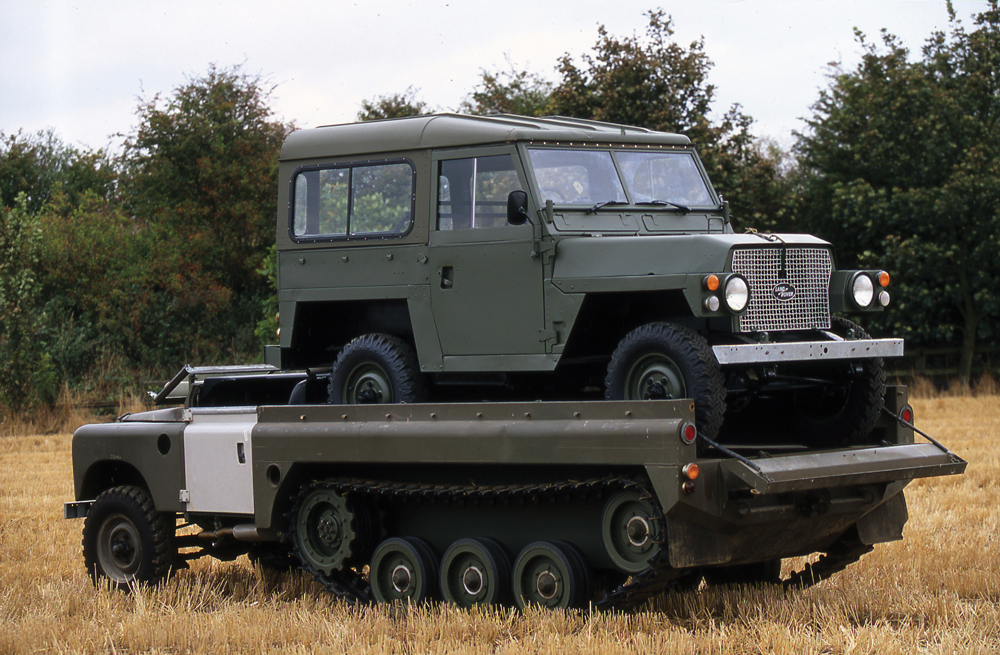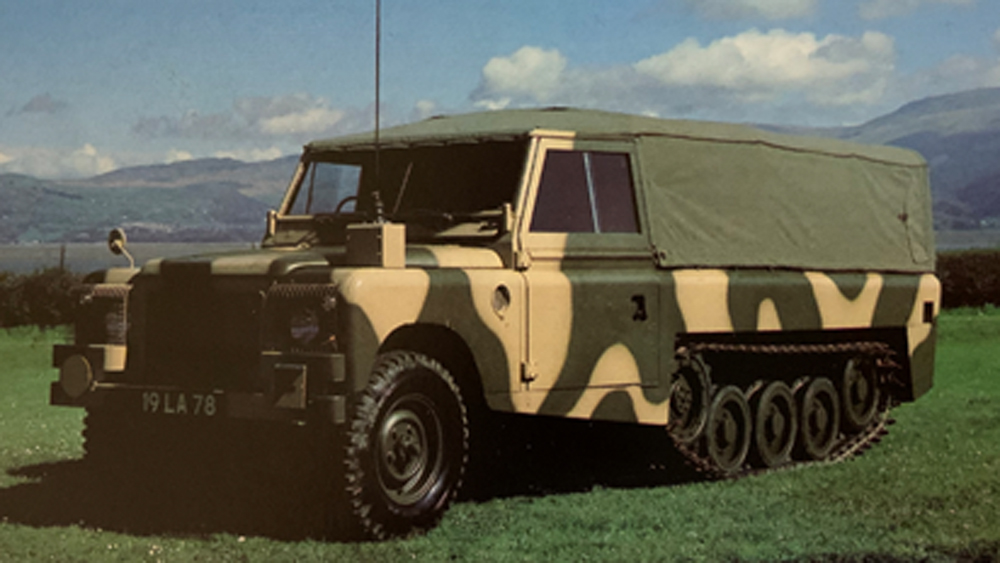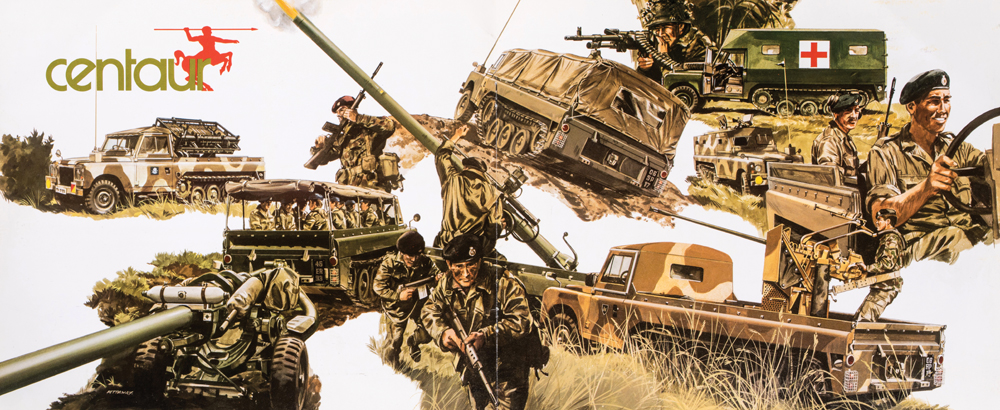11 August 2023
|
We conclude our research into the fascinating Laird Centaur and meet the owners of two more of the six survivors…
In part one of this story, we described the Land Rover Centaur that was developed in the late 1970s by Laird (Anglesey) Limited as a speculative private venture. Laird thought it had identified a gap in the market and was prepared to invest heavily to create a concept vehicle and at least six pre-production vehicles, as well as fund a series of overseas sales tours and demonstrations to potential purchasers.
The example we introduced in part one is now in the care of the Dunsfold Collection, on loan from the Tank Museum at Bovington. It is a unique example because its Land Rover front end comes from a One Ten. As related last month, all six pre-production examples were built using Stage I V8 front ends. Whether Dunsfold’s One Ten Centaur was a seventh pre-pro (or indeed an eighth, as suggested by the Tank Museum files), or a rebuild of the concept vehicle or one of the six pre-pros is far from clear, and we’re determined to get to the bottom of it.

Apart from the deafening noise levels and huge turning circle, the Centaur drives just like a Land Rover
Research confirms that in addition to the Dunsfold example, five Centaurs are known to survive, so it seems logical to find out as much as possible about these and see if their stories provide any clues that help us to understand how a One Ten delivered to Laird in January 1984 came to be mated to a Centaur rear chassis, over four and a half years after the last of the six pre-production vehicles was completed.

P1 during winter trials in Norway. Registration 06 SP 17 seems to have been carried by most of the pre-pros
It is believed that the concept vehicle was scrapped, and of the six pre-production examples recorded in the contemporary press reports mentioned in last month’s LRM, only one is unaccounted for, and that is P1. Rumour has it that after a sales tour to Libya it did not return, and no trace of it has (yet) been found. Which means that there is a remote possibility that Dunsfold’s example could be P1, updated at some stage by Laird with a One Ten front end delivered to the company in January 1984. It’s pretty unlikely.
Shortly after they were completed in 1979, most of the pre-pros seem to have embarked on an intensive series of overseas trials, with vehicles being loaned to interested parties for a few weeks before moving on to the next. One vehicle, P4, was assessed by the Omani military in August 1979 and they insisted on buying it immediately. It cost them a not inconsiderable £37,500, and it is currently on display at the Sultan of Oman’s Armed Forces Museum near Muscat.

Centaur’s rear load space can accommodate a Lightweight with ease
P5 is the other example in store at the Tank Museum at Bovington. It was apparently used in field trials by 9 Para Squadron, Royal Engineers, and was evaluated as a bar minelayer in Exercise Towbar in East Anglia in late 1979. It was later sent to Rheinmetall to be fitted with an S20 Pintle Mount and a Mk20 Rh202 20mm Automatic Cannon installation, and is believed to have been demonstrated at the British Army Equipment Exhibition in 1980. It was donated to the Tank Museum by Laird in 1989, and subsequently loaned to the B-Vehicle Museum at Ripley, who registered it with the number Q442 DPG in August 1994. It returned to Bovington in May 2013.
P6 is another of the survivors, and its story is perhaps the most remarkable. It is believed to have been acquired in 1980 by the military authorities in Iraq, and rumours abound that a certain Saddam Hussein was drawn to it and decided it would be a useful addition to his military might. It was discovered there in 2005 by allied forces during the Iraq War, bearing all the signs of having been used for target practice. Whatever the truth of the matter, the story goes that the American military intended to recover it to the US but it was miraculously repatriated to the UK instead. It appeared at the Dunsfold Collection Open Weekend in 2006 and was offered for sale on eBay in February 2016. It was acquired by French Land Rover collector Sébastien Conte.

Pete Blanchard succeeded in persuading the DVLA to issue a reg number for P2. Top speed is 50mph
And that just leaves P2 and P3, both of which were sold by makers Laird (Anglesey) Ltd in 1989, around the same time that Laird donated the two Centaurs to the Tank Museum. The buyer was Peter Blanchard, founder and owner of the well-known Land Rover parts and military vehicle specialists P A Blanchard of Market Weighton. It seemed sensible to pay a visit to Pete and his son, Nick, so a plan was made which somehow meant I drew the short straw and had to set my alarm for an 04:00am wake-up. By 05:30am, Philip and I were on our way for a 500 mile round trip that would, together with parallel research that I was conducting into the machinations of the Thatcher government, provide us with the best possible explanation as to how a 1984 One Ten became a Laird Centaur.
Laird (Anglesey) Limited was founded in 1940 at Beaumaris to repair military flying boats. With expertise in aluminium alloy fabrication, the company diversified during the Second World War and later developed the Trackway product range, which was designed to improve the capability of military expeditionary vehicles in difficult terrain conditions. Trackway products were also developed to construct temporary airfield runways, as well as repairing battle-damaged airstrips, for military customers worldwide.

Flared doors very obvious in this front view; rear body is 16in wider than the Land Rover front end
In 1996 the company was acquired by German-owned Faun GmbH, part of the Kirchoff Group, and became Faun Municipal Vehicles Ltd, designers and manufacturers of refuse collection vehicles and sweepers, and Faun Trackway solutions for military customers. The company still operates from its Anglesey base today.
In 1989, Laird decided to dispose of its remaining Centaurs and Pete Blanchard bought pre-pros P2 and P3, the latter with its fascinating hard top still in situ. Pete had the opportunity to discuss the Centaur programme in great detail with Laird’s George Stowell, who went on to become a director of the Trackway business after Faun acquired Laird.

Anoraks at large: Gary and Philip got very excited delving into Pete Blanchard’s files
As well as acquiring two more or less complete Centaurs, Pete was also given extensive documentation on the development programme as well as dozens of official Laird photographs and engineering drawings. For a Land Rover researcher and historian like me, it is a veritable treasure trove.
Pete and I compared notes, and he was delighted to take copies of a couple of Laird brochures he hasn’t seen before. We confirmed that our records of the VINs of the six Stage 1 109s supplied by Land Rover in 1979 match, and Land Rover production records confirm they were delivered to Laird in February and April 1979.

Laird publicity photo shows one of the RHD pre-pros fitted with the fake 19 LA 78 number plates
And then Pete told us about something that was included in his deal with Laird that Philip and I had not heard of before. As part of the deal, Pete had acquired a Stage I front end comprising the front chassis, front axle, engine, gearbox, and bodywork. He had since disposed of it but kept the chassis plate for posterity. VIN SALLBCAV1AA 186069 was despatched from Land Rover to Laird on 25 April 1983, and George Stowell told Pete that it was fitted to a seventh Centaur that Laird identified as ‘DTI’.
Pete only had the front end of that Stage 1 and, based on his conversations with George, he believes the reason he only had the front end was because less than a year after they had made DTI, Laird bought a coil-sprung One Ten and used its front end to replace the Stage 1 front end on DTI.

The cockpit is standard Stage 1 Land Rover apart from the prominent rev counter mounted in the centre of the dash
If this is true, it means that Dunsfold’s Centaur is the seventh pre-production vehicle built, or the eighth Centaur if the prototype is included. But it still begs the question: why did Laird build a seventh example in 1983, and then go to the trouble and cost of upgrading it with a coil-sprung One Ten front end the following year?
The clue is in the designation ‘DTI’ used by Laird for the seventh pre-pro, which stands for Department of Trade & Industry, the government department responsible at that time for, among other things, the securing of export orders for British manufacturers.

One of several weapons systems trialled in the Centaur pre-production vehicles
In the early 1980s, one such potential overseas sales opportunity was emerging in Chile, which had been ruled by the dictator General Augusto Pinochet since 1973. In January 1984, the Department of Trade & Industry issued an export licence for a Centaur to be delivered to the South American Country for demonstration purposes, in response to a potential order for 300 vehicles from the Chilean government. The Centaur delivered to Chile was the One Ten pre-pro vehicle known as DTI.
The story was reported in New Statesman magazine in May 1985 by the renowned investigative journalist Duncan Campbell, who wrote, ‘The Centaur, which with official British permission is already in Chile on demonstration to the Chilean army, is a lightly armoured gun carrier described by its makers as suitable for a wide range of internal security activity… with outstanding potential in both fighting and support roles, with a choice of weapons systems, bodies, and equipment fits that results in a versatility unequalled by any current vehicle design’. But doing business with the Pinochet regime was a political hot potato, and no order was forthcoming.

Pete Blanchard succeeded in persuading the DVLA to issue a reg number for P2. Top speed is 50mph
Pete Blanchard was more successful in his battle with the DVLA when he decided to register P2 in order to be able to drive it on the road. It is also interesting to note that P2 was originally in Land Rover’s care, having been its assessment and demonstration vehicle, and it was loaned to the Dunsfold Collection in 1988. In fact, Land Rover delivered the vehicle to the Rushmoor Steam & Vintage Rally at Aldershot in Hampshire, where Philip Bashall had organised a gathering of 40 assorted Land Rovers to celebrate the 40th anniversary. At the end of the show, Philip drove the Centaur home! It was overhauled and repainted at Dunsfold, but within a year Laird came knocking and asked for it back, to join P3 in the disposal sale that ended with both P2 and P3 being bought by Pete.

Stage 1 V8 was de-restricted to match contemporary Range Rover outputs
Laird must have been devastated when no orders came in, not least because as well as the costs involved in developing the prototype and the pre-production vehicles, the company had also ordered production tooling and put plans in place to build 150 Centaurs per year from 1980.
It’s difficult to view the Centaur as anything other than an expensive white elephant that promised much and delivered very little, which is probably what makes it so interesting to us today.

Watch Dunsfold's One Ten V8 Centaur in action here
The daft-but-wonderful Centaur One Ten went on display in June this year when the Dunsfold Collection opened its new museum building. This was a private, invitation-only event for Friends of the Collection and Wall of Fame members, as a special thank you for their support. The Collection will be announcing open days for the public later in 2023. Or become a Friend of the Collection to receive a regular newsletter, and to support the Collection.
The Fabulous Centaurs

Prototype (built 1978): Based on a second-hand Series III 2.25-litre diesel. Later re-engined with a V8. Exhibited at BAEE June 1978, then participated in a three-month MoD overseas sales tour. Believed scrapped.
P1 (1979) LBCAV1AA 100058: Delivered February 1979. Limestone. RHD. Testing at MIRA. Cold weather testing in Norway. Hot weather testing in Libya and Tunisia. Minelayer and cannon trials. Fate unknown, but possibly remained in Libya after a sales tour.
P2 (1979) LBCAV1AA 100057: Delivered February 1979. Limestone. RHD. Sales tours of Kenya and Nigeria. Land Rover assessment and demonstration vehicle. Loaned to the Dunsfold Collection in 1988. Acquired from Laird in 1989 by P A Blanchard & Co Ltd. Peter Blanchard secured its registration with the DVLA as RKH 493T 06.1991. Owned by Peter Blanchard, UK.
P3 (1979) LBCAV1AA 100059: Delivered April 1979. Limestone. RHD. To Racal Tacticom for fitting out with electronics and radios. Modified for trials with a hard top body fitted with radios for use as a mobile command post. Acquired from Laird in 1989 by Peter Blanchard. Currently owned by P Blanchard, UK.
P4 (1979) LBCAV2AA 100062: Delivered April 1979. Limestone. LHD. Sent to Oman August 1979 and purchased by the Omani military. Currently in the Sultan of Oman’s Armed Forces Museum, Bait al Ajaj Fort, Muscat, Oman.
P5 (1979) LBCAV2AA 100063: Delivered April 1979. Limestone. LHD. 9 Para Sqn, Royal Engineers, used as a bar minelayer in Exercise Towbar held in East Anglia October 1979 to December 1979. Sent to Rheinmetall for 20mm cannon install. Believed shown at BAEE in 1980.
Donated to the Tank Museum by Laird in 1989 and loaned to the B-Vehicle Museum at Ripley, who registered it as Q442 DPG 08.1994. Returned to
Bovington May 2013. Currently in the Tank Museum, Bovington.
P6 (1979) LBCAV2AA 100061: Delivered April 1979. Limestone. LHD. Sold to Iraq in 1980. Found in Baghdad in 2005 having apparently been used for target practice. Recovered to the UK. Sold February 2016. Part of the Sébastien Conte collection, France.
DTI (1983) SALLBCAV1AA 186069: RHD. Delivered to Laird on 25 April 1983. This Stage 1 front end is believed to have been replaced with the front end from LHD One Ten V8 SALLDHAV2AA 204569 despatched from Solihull on 9 January 1984.
Military demonstrator in Chile 1984-85. Donated by Laird to the Tank Museum in 1989. Currently in the Dunsfold Collection.
Like to have your own Land Rover library?
Try our Budget Digital Subscription. You'll get access to over 7 years of Land Rover Monthly – that’s more than 100 issues plus the latest digital issue. All issues are fully searchable so you can easily find what you are looking for and what’s more it’s less than 10p a day to subscribe. Click here to find out more details and start enjoying all the benefits now.





